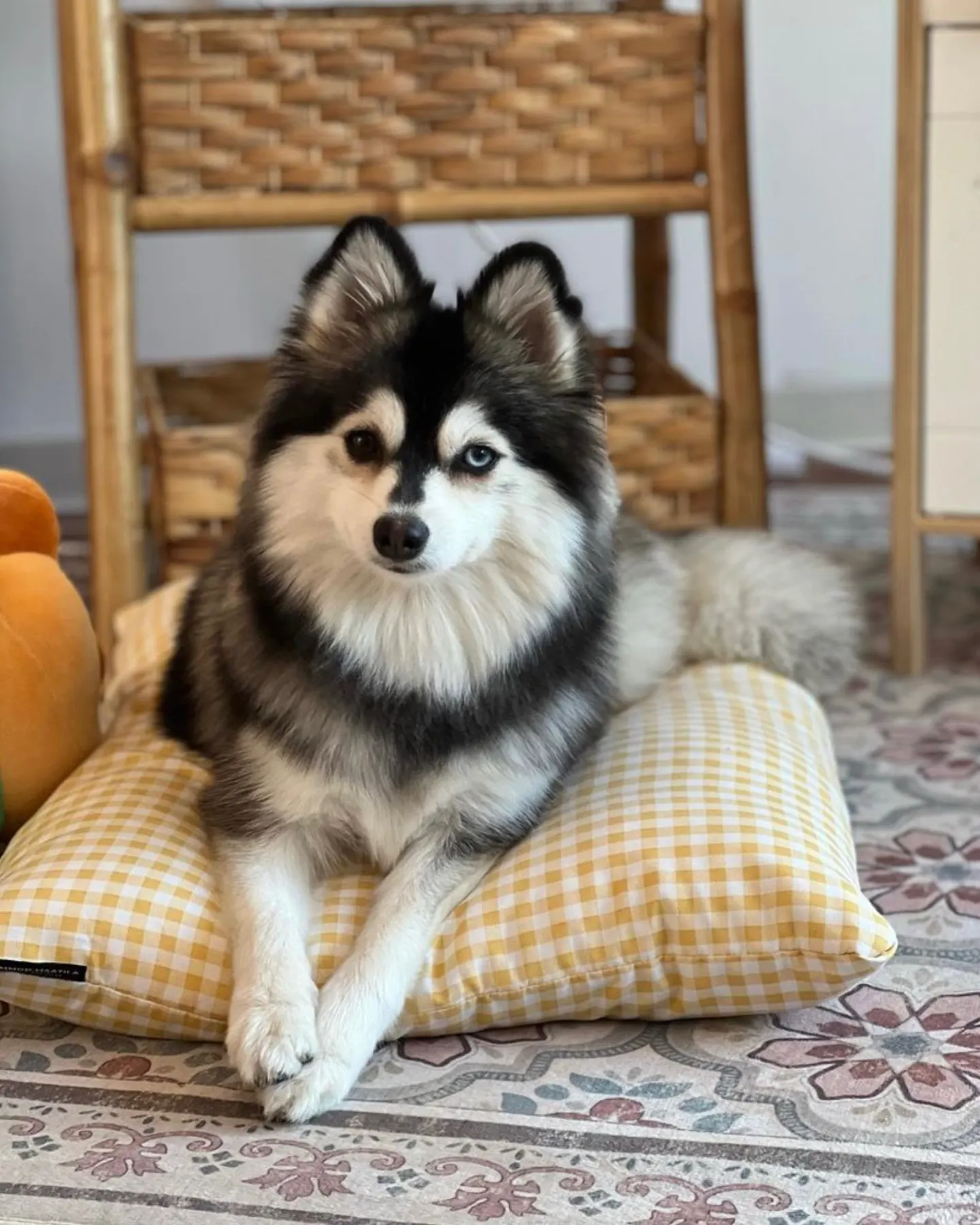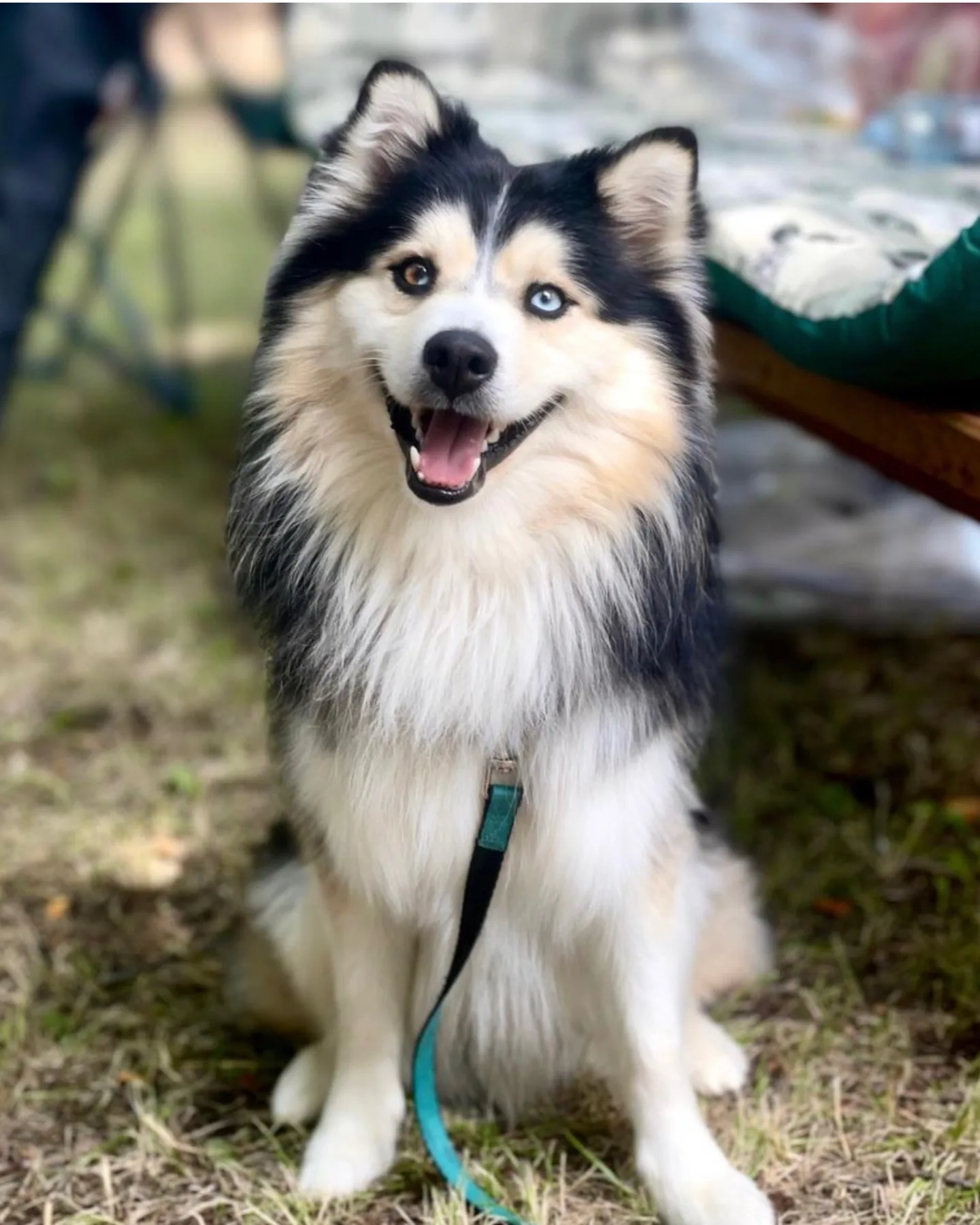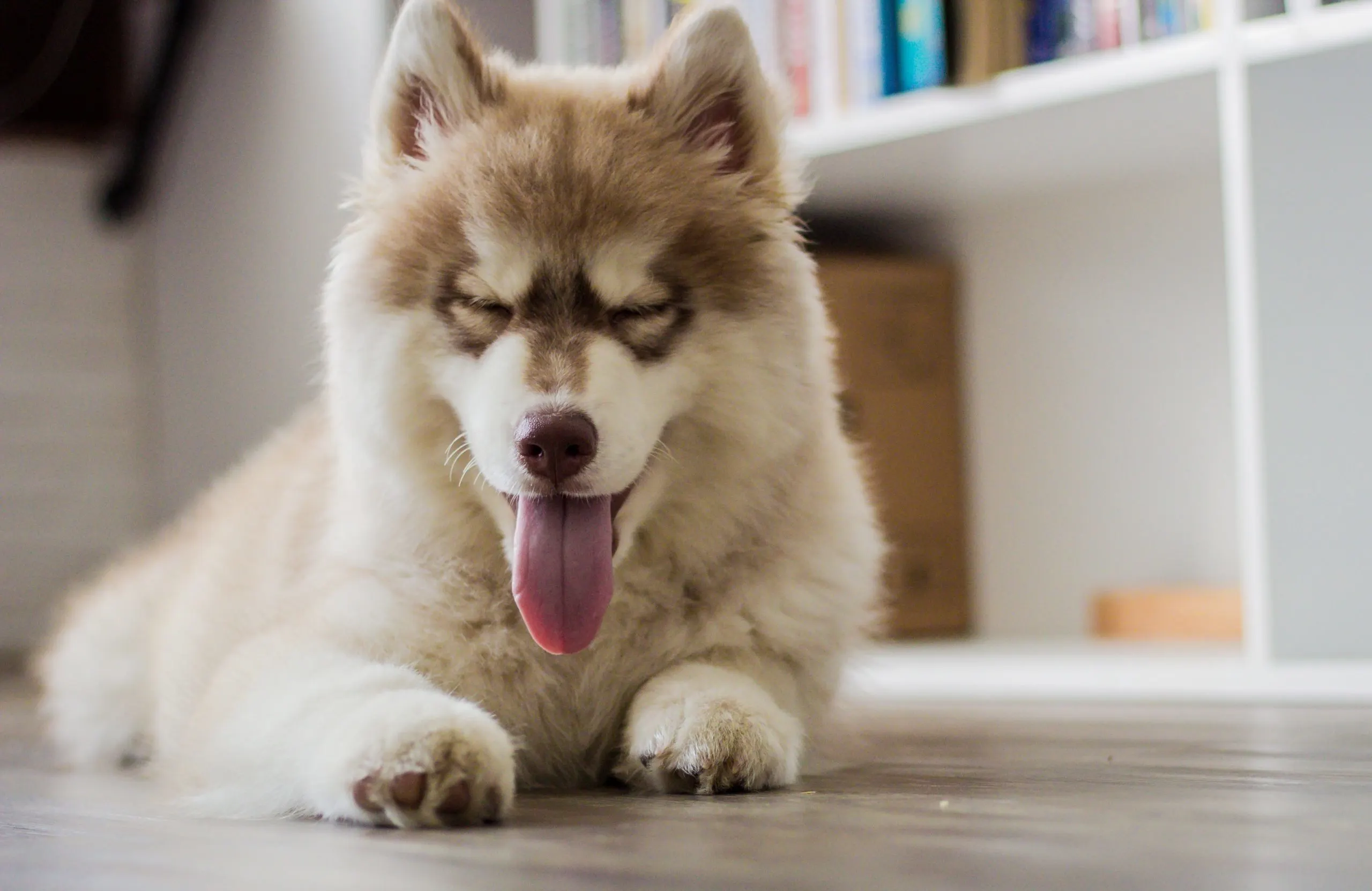Have you heard about the Pomsky? This is an adorable designer dog created by breeding a Husky and Pomenarian together. They are unbelievably cute, they have unconditional love for small children, and their bubbly personalities would convert anyone into a dog person. But before you call one of these babies your own, you are probably wondering – How big does a Pomsky get? Well, the answer is, it depends.
While you can be sure that your Pomsky will be the ideal family dog, it’s a bit more complicated to predict the adult weight and standard length. But every true dog lover already knows that. The most important thing is that your pet dog and you get along together. And a few inches more or less won’t stand in the way of that, right?
The average height of an adult Pomsky depends on the size of his parent dog breeds. There are different sizes of both the Husky and the Pomeranian. So we can’t tell you the EXACT measurements of a Pomsky adult. However, what we can do is give you a Pomsky growth chart with predictions for different stages of your dog’s life.
How big do Pomskies get will also depend on things other than his gene pool. We will answer all of the important questions and tell you what factors contribute to the Pomsky size. So let’s dive in and find out all about the growth of the Pomeranian Husky mix.
What affects the growth of a Pomsky?
Like any dog, your Pomsky needs a balanced diet and regular exercise to stay healthy. Pomeranians and Huskies are both extremely active breeds, therefore Pomskies share that characteristic. They do great with a nice long walk or lots of playtime, but they require a lot of activity. Their food will also be very important to their healthy development.
They require the correct fuel to maintain their high level of energy. Since every Pomsky is unique, you should talk to your veterinarian about this. But to help your dog grow in a healthy way, make sure that his diet contains lots of protein. Protein is the one thing that muscles are made of, so a protein-based diet will help your canine grow tall and strong.

Source: Instagram (@pomsky_ashe)
Does spaying or neutering affect their growth?
The reproductive organs—the testicles in the case of male dogs and the ovaries in the case of female dogs—are surgically removed during spaying and neutering. The signals that growth hormones receive from reproductive hormones are crucial, particularly when it comes to the growth plates closing.
Because of this, Pomskys will grow taller than typical if you spay or neuter them before they reach sexual maturity. The ideal time to spay or neuter your Pomsky is between the ages of 6 and 9 months, but you should consult your veterinarian for an exact time frame.
Spaying or neutering your dog has certain advantages. Spaying ladies lowers the incidence of ovarian cancer and prevents conception. Neutering males lowers the likelihood of testicular cancer, diminishes aggressive behavior, and prevents unwanted reproduction.
Do Pomskies come in different sizes?
Due to the significant differences in height and weight between the two parent breeds, Pomskies can vary greatly in size. Siberian Huskies are a medium breed, while Pomeranians are considered toy dogs. As a result, the majority of Pomskies will be categorized as a smaller breed too. When selecting to buy or adopt a Pomsky, you should be prepared for the possibility that you will end up with a medium-sized dog as well because genetics can be unexpected.
Some people will purposely breed Pomskies to be as small as possible, which results in teacup Pomskies. However, we do not suggest buying one of these puppies. There are numerous problems associated with this variety of dogs, and the risk is simply too big. In addition to that, the breeders who do that don’t have the dog’s best interest at heart. Instead, they are just looking for a quick cash grab.
Why you should avoid teacup Pomskies
We know that teacup dogs are adorable. They are just so tiny and sweet, and it’s so hard to resist them. However, in the case of Pomskies, you definitely should. We have a whole article on why breeding teacup Pomskies is dangerous. But if you want the short version, then you should know that the chances of you bringing a sick puppy home are just too high with this teacup breed.
In order to breed such small dogs, breeders will sometimes get runts, or dogs from a litter that are much smaller or weaker than the others, and pair them with other runts. They do this with the aim of having a litter of canines that are smaller than typical. What’s even worse they will sometimes even negatively affect the puppies’ growth by underfeeding them.
Obviously, these methods are incredibly harmful to the health and happiness of the dogs! And also, puppies who are malnourished or underfed can have major problems with their skeletal, digestive, and nervous systems. That’s why buying teacup Pomskies is risky. But besides that, you will also support backyard breeders who are only in it for the money.
Pomsky Growth Chart
The majority of Pomskies reach their full skeletal development at roughly one year of age. This indicates that their bones have grown to their entire length and they are now at their tallest possible point. Up to the age of 18 months, the majority of Pomskies will continue to bulk up and add muscle and fat to their frame.
Pomskies may still be developing, but they will be sexually mature before they turn one. At about 6 to 9 months old, both male and female Pomskies will begin to display symptoms of sexual maturity. Therefore, as the new hormones begin to take effect, be prepared to handle behavioral changes. Consult your veterinarian about neutering or spaying your dog if you don’t intend to breed them.
Because both of your puppy’s parents are known to be active, inquisitive, sociable, and a little bit mischievous, don’t expect their playful nature to fade as they get older; in fact, they will maintain it. Your Pomsky will have finished growing and developed to their full sexual, physical, and mental potential by the time they turn 18 months old.
Pomsky Size and Weight Prediction
Any dog’s exact height and weight are extremely difficult to estimate, but it’s especially difficult for designer dogs. And in addition to that, the Pomsky is a fairly newer designer dog as well. So we don’t have that much info on them at all. On the other hand, there is a ton of information on their parent dog breeds, as the Husky and Pomeranian have been around for decades.
Years of research have allowed us to make fairly precise forecasts about these dogs’ potential sizes. With Pomskies, however, this is not the case. It is quite difficult to anticipate the characteristics of the upcoming generations because there are not many studies to draw on. Breeders may still roughly estimate the size of the Pomsky by comparing it to the size and weight of each parent breed of dog. Although it may not always be exact, it is generally close.
The average weight of both a Husky and a Pomeranian is used to calculate the size and weight of Pomskies. For instance, if the Husky weighs 35 pounds and the Pomeranian weighs 5 pounds, their combined weight is 40 pounds. That is equal to a 20-pound Pomsky when divided by two.
Given that the precise weight is unpredictable, this is obviously only a preliminary approximation. However, it can provide you with a rough estimation of Pomsky’s typical weight. The dog’s height is calculated using the same formula. You may roughly estimate the height of the Pomsky by using the average height of the two breeds.

Source: Instagram (@tkpomskiesofcanada)
Puppy Stage
Almost all dog owners absolutely love the puppy stage of their dogs. Everyone adores a new puppy, right? Puppy-like in appearance, Pomsky puppies are little charming balls of fluff.
A Pomsky puppy usually weighs around 5 pounds when it is prepared to move into a new family. At this young age, they hardly stand taller than half a foot. Pomskies develop fairly quickly as all dogs do. Given that most dogs seem to develop rapidly before our very eyes, this is totally normal.
At three months old, Huskies weigh half their adult weight, and by six months old, they weigh seventy percent. At three months, they weigh between 18 and 30 pounds, at six months, between 26 and 43 pounds, at one year, between 34 and 57 pounds, and at adulthood, between 35 and 60 pounds.
Pomeranians, on the other hand, grow mainly during the first six months of life and achieve mature weight at one year. At three months old, they weigh 1 to 2 pounds, at six months, 2 to 5 pounds, and at maturity, 3 to 7 pounds.
Pomskies grow considerably over the first six months of their lives. Being a small breed, they will reach 50% of their adult weight between the ages of three and four months, and between the ages of 12 and 15 months, they move to the adult stage of their life.
Adult dog
Pomskies can reach heights of 10 to 15 inches and weights of 20 to 30 pounds. The Pomsky breed, however, is unpredictable and its size might change with each litter. As you can tell, they are smaller than the Husky, but not significantly. They are all still cute no matter what size they get, and don’t try to play with nature by looking for a Teacup size.
Although it is difficult, sizes can be estimated. When putting your trust in a breeder, be cautious! It is a red flag if your breeder promises he knows exactly how big your puppy is going to be. If they do, their intentions may be dubious because they shouldn’t be able to promise anything regarding size or look. As this is a mixed breed, you can never be certain what you are going to get.
All we can say is that your dog will be a smaller breed. But in some rare cases if they are more like their Husky parents, they may be considered small to medium. For those seeking a large dog mentality in a small dog body, their petite stature is ideal. They truly do combine the best of both worlds.
Senior age
Senior Pomskies do not much change in size from when they were adults, but their weight does change with time. Pomskies slow down as they age, just like any senior dog. If owners are not careful, this could lead to weight gain, therefore they must carefully manage their food to keep the senior dog healthy. Pomeranians have small legs, and Pomskies appear to inherit this characteristic.
When puppies are overweight, their small legs are put under an excessive amount of stress, which can hurt them and lead to other issues. But it’s not only food that you have to think about, but treats can also become a problem. That’s why you have to keep track of how many treats you are giving your dog during the day. No matter how much of a good boy or girl he is, it’s for his or her own good to limit their treats.
When your Pomsky reaches his senior age, you should still make sure that his diet is mostly protein based. This will also help that he does not lose too much muscle weight, and it will keep him fueled to still stay active even as a senior. The most important thing you can do for your dog during this stage is to make sure he gets enough vet visits and health checkups so that any possible conditions can be diagnosed and treated in time
Conclusion: How big will my Pomsky get?
As there are large Huskies, larger Pomeranians, tiny Huskies, and tiny Pomeranians, there are also certain size differences of a Pomsky. In order to get an idea of how big do Pomskies get, the best idea is to ask your Pomsky breeder how big his parents are. That will be the best prediction on your Pomsky size.
While most of them are small dogs, there are still some exceptions. So if size really does matter to you, it would be a good idea to inform yourself about the adult size of his parents. This is a new designer dog, that obviously isn’t recognized by the American Kennel Club, so there isn’t any breed standard to guide you through. If you are unfamiliar with the breed, Google pictures of Pomskies to at least get an idea of their different sizes.
But besides the genes, the most important thing you can do to make sure your active dog grows to its full potential is to provide him with a healthy life. They need high-quality dog food and enough exercise from their puppy stage. A good lifestyle will also prevent some health complications that these designer dogs are prone to.
However, be sure that you will get a loving companion, a full-time cuddle buddy, and a happy-go-lucky ball of fur by your side if you decide to adopt a Pomsky. Their Pomeranian genes give them a big personality and fluffy thick coat, while they inherit their loyalty and sense of humor from their Husky parents.
Are you already the proud owner of one of these puppies? If you are, make sure you leave us a comment telling us all about your precious little fur baby.

